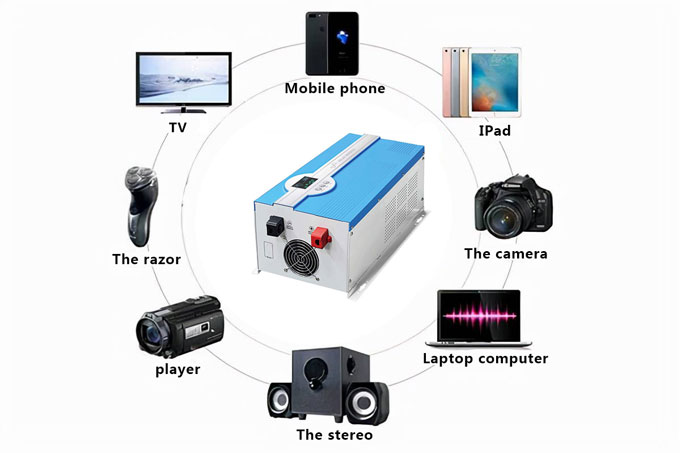In modern power systems, off-grid inverters play a crucial role. They not only convert DC power into AC power, providing stable electricity for various loads but also ensure the normal operation of critical equipment during power quality issues or supply interruptions. However, the performance of off-grid inverters is closely related to the type of load, and different types of loads place different demands on the inverters. Today, Inverter.com will delve into the types of loads for off-grid inverters and how these load types impact inverter performance.
Classification of load types
Off-grid inverter load types can be broadly classified into three categories: resistive loads, inductive loads, and capacitive loads.
- Resistive Loads: Resistive loads are those where the current and voltage are in phase, meaning there is no phase difference. Examples include rice cookers, light bulbs, electric furnaces, and soldering irons. The current and voltage waveforms for these loads are synchronized, resulting in stable output voltage and current waveforms from the inverter. Consequently, the requirements for the inverter are relatively low.
- Inductive Loads: Inductive loads are characterized by a phase difference where the current lags behind the voltage. Examples include washing machines, air conditioners, refrigerators, water pumps, and range hoods, all of which contain electric motors, as well as transformers, relays, and compressors. These loads require a much larger current at startup, typically 3 to 5 times the rated current, which places higher demands on the inverter's overload capacity. Additionally, the current waveforms of inductive loads can be distorted, potentially affecting the inverter's output voltage and current waveforms negatively.
- Capacitive Loads: Capacitive loads are those where the current leads the voltage by a phase difference. Examples include compensation capacitors, computers, and televisions. The current and voltage waveforms for these loads are out of phase, which can cause phase shifts in the inverter's output voltage and current waveforms, potentially impacting the inverter's performance. Additionally, when integrated with a solar panel system, the overall stability and efficiency of power conversion can be affected by these phase shifts.

Impact of load types on inverter performance
Different load types affect the performance of off-grid inverters in various ways.
- Impact of Resistive Loads: Resistive loads have minimal impact on inverter performance. Since the current and voltage waveforms are synchronized for resistive loads, the inverter’s output voltage and current waveforms remain stable. However, when the power of resistive loads is substantial, the inverter must handle significant current and power output, which imposes demands on its thermal performance and overload capacity.
- Impact of Inductive Loads: Inductive loads significantly impact inverter performance. Firstly, inductive loads require a large current during startup, which can cause distortion in the inverter’s output voltage and current waveforms. Secondly, the current waveforms of inductive loads are often distorted, potentially adversely affecting the inverter’s output stability. Additionally, the power factor of inductive loads is typically low, which can reduce the inverter’s efficiency. To mitigate the effects of inductive loads, some off-grid inverters employ specific control strategies, such as positive and negative sequence control. This strategy allows independent control of the phase and amplitude of positive and negative sequence components, effectively suppressing waveform distortion caused by load imbalances and maintaining the stability of the output voltage and current. However, this control strategy poses challenges in terms of algorithm complexity and hardware design, requiring higher levels of precision and sophistication. For instance, an 8kW off-grid solar inverter needs to address these challenges to ensure efficient and reliable performance.
- Impact of Capacitive Loads: Capacitive loads mainly affect the inverter by causing phase shifts in the output voltage and current waveforms. Since the current waveform of capacitive loads leads to the voltage waveform, this can result in phase shifts in the inverter’s output, potentially impacting sensitive equipment. To minimize the impact of capacitive loads on the inverter, compensatory measures can be taken, such as adding compensation capacitors or adjusting the inverter’s control parameters.
Selection and configuration of off-grid inverters
Select the Right Inverter Based on Load Type. For resistive loads, standard off-grid inverters can be used. For inductive loads, select inverters with high overload capacity and specific control strategies, such as those based on positive and negative sequence control. For capacitive loads, choose inverters with phase compensation capabilities.
Determine Inverter Capacity Based on Load Power. When selecting an inverter, the capacity must be determined based on the load power. Choose an inverter capacity that matches the load power directly. Consider the impact of startup current and power factor on the inverter, and appropriately increase the inverter capacity. Additionally, factor in the startup power and peak power of the loads when calculating the inverter’s required power.
Properly Configure the Inverter and Load Connections. When configuring the connection between the inverter and the loads, ensure safety and avoid overload and short circuits. Use capacity expansion designs to ensure the inverter’s output capacity meets the startup and operational demands of the loads. Pay attention to the inverter’s thermal performance and the working environment temperature, as these factors can affect the inverter’s performance.
The performance of off-grid inverters is closely related to the type of load they support. Different load types place different demands on the inverters, requiring comprehensive consideration and configuration based on actual conditions. By selecting the appropriate inverter and configuring its connections properly, you can ensure stable operation and meet the needs of various loads. Additionally, with continuous advancements and improvements in power technology, the performance and functionality of off-grid inverters will continue to enhance and evolve. If you need assistance in selecting the most suitable off-grid inverter for your PV system, please contact us. Our team of experts will help you find the perfect solution tailored to your needs.
